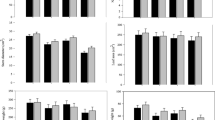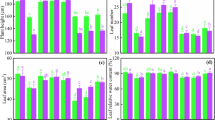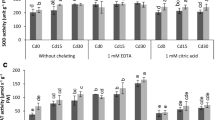Abstract
Cadmium (Cd) stress is highly damaging to plant growth but its toxicity can be alleviated with exogenous supply of growth promoters. In this greenhouse study, we determined the effectiveness of medium-supplemented thiourea (TU) in improving growth, leaf gas exchange, and photosynthetic pigments contents. Pak-Afgoi (Cd-tolerant) and EV-20 (Cd-sensitive) maize (Zea mays L.) varieties were grown in pots containing sand supplemented with nutrient solution for 30 days. The plants were treated with 1,000 µM or without Cd. On the appearance of Cd-toxicity symptoms (in about 10 days), a pre-optimized level of TU (0.25 mM) was supplemented in the rooting medium, and plants were allowed to grow for further 15 days. Data for various growths, leaf gas exchange characteristics, chlorophyll (Chl), and carotenoids (Car) contents were recorded in spring (February–April) and autumn (August–October) seasons. Results showed that Cd-stress significantly decreased length, fresh and dry weight of shoot and root, number of green leaves and leaf area per plant, net photosynthetic rate (P n), transpiration rate (TR), stomatal conductance (g s), Chl-a, -b, Chl-a-to-b ratio, and Car but increased substomatal CO2 concentration (C i ) in the varieties in both the seasons. Although Cd was toxic to maize, medium-supplemented TU nullified the Cd-toxicity as was evident from improved growth, P n, g s, and Chl-b and Car contents in both varieties. Overall, 0.25 mM TU level was quite effective in reducing the Cd-toxicity on both the maize varieties; especially, sensitive maize more profoundly responded to Cd-toxicity under medium supplementation of TU. Cd-tolerance produced by TU was superior in the autumn- than in spring-grown maize. From the reduced Cd content of leaf and root, the results suggested a possible role of TU in reducing Cd-availability to the root and its transport to shoot. Presence of thiol group in TU appears to be important to Cd-binding/inactivation, and thus its tolerance by maize.




Similar content being viewed by others
References
Akladious SA (2014) Influence of thiourea application on some physiological and molecular criteria of sunflower (Helianthus annuus L.) plants under conditions of heat stress. Protoplasma 251:625–638
Amirjani MR (2012) Effects of cadmium on wheat growth and some physiological factors. Int J For Soil Eros 2:50–58
Anjum F, Wahid A, Farooq M, Javed F (2011) Potential of foliar applied thiourea in improving salt and high temperature tolerance of bread wheat (Triticum aestivum L.). Int J Agric Biol 13:251–256
Asthir B, Thapar R, Farooq M, Bains NS (2013) Exogenous application of thiourea improves the performance of late sown wheat by inducing terminal heat resistance. Int J Agric Biol 15:1337–1342
Bahmani R, Bihamta MR, Habibi D, Forozesh P, Ahmad SI (2012) Effect of cadmium chloride on growth parameters of different bean genotypes (Phaseolus vulgaris L.). ARPN J Agric Biol Sci 7:35–40
Balestrasse KB, Benavides MP, Gallego SM, Tomaro ML (2003) Effect of cadmium stress on nitrogen metabolism in nodules and roots of soybean plants. Funct Plant Biol 30:57–64
Bansal P, Sharma P (2000) Effect of Pb24 and Cd on respiration and mitochondrial electron transport chain in germinating pea seeds (Pisum sativum). Ind J Environ Ecol 3:249–254
Baryla A, Carrier P, Franck F, Coulomb C, Havaux M (2001) Leaf chlorosis in oilseed rape plants (Brassica napus) grown on cadmium polluted soil, causes and consequences for photosynthesis and growth. Planta 212:696–709
Cao H, Wang J, Zhang X (2007) Ecotoxicity of cadmium to maize and soybean seedlings in black soil. Chin Geogr Sci 17:270–274
Chen X, Wang J, Shi Y, Zhao MQ, Chi GY (2011) Effects of cadmium on growth and photosynthetic activities in pakchoi and mustard. Bot Stud 52:41–46
Costa G, Michaut J, Morel J (1994) Influence of cadmium on water relations and gas exchanges in phosphorus deficient Lupinus albus. Plant Physiol Biochem 32:105–114
Dalla Vecchia F, La Rocca N, Moro I, De Faveri S, Andreoli C, Rascio N (2005) Morphogenetic, ultrastructural and physiological damages suffered by submerged leaves of Elodea canadensis exposed to cadmium. Plant Sci 168:329–338
Dat J, Vandenabeele S, Iranova E, Van Montagu M, Inze D, Van Breusegem F (2000) Dual action of the active oxygen species during plant stress responses. Cell Mol Life Sci 57:779–795
Davies BH (1976) Carotenoids. In: Goodwin TW (ed) Chemistry and biochemistry of plant pigments, vol 2. Academic Press, London, pp 38–165
Day SD, Wiseman PE, Dickinson SB, Harris JR (2010) Tree root ecology in the urban environment and implications for a sustainable rhizosphere. Arboric Urban For 36:193–205
de Pascale S, Maggio A, Fogliano V, Ambrosino P, Ritieni A (2001) Irrigation with saline water improves carotenoids content and antioxidant activity of tomato. J Hortic Sci Biotechnol 76:447–453
El-Beltagi HS, Mohamed AA, Rashed MM (2010) Response of antioxidative enzymes to cadmium stress in leaves and roots of radish (Rahpanus sativus L.). Not Sci Biol 2:76–82
Faizan S, Kausar S, Perveen R (2011) Varietal differences for cadmium-induced seedling mortality, foliar toxicity symptoms, plant growth, proline and nitrate reductase activity in chickpea (Cicer arietinum L). Biol Med 3:196–206
Farooq M, Wahid A, Kobayashi N, Fujita D, Basra SMA (2008) Plant drought stress: effects, mechanisms and management. Agron Sustain Dev 29:185–212
Garg BK, Burman U, Kathju S (2006) Influence of thiourea on photosynthesis, nitrogen metabolism and yield of cluster bean [Cyamopsis tetragonoloba (L.) Taub.] under rainfed conditions of Indian arid zone. Plant Growth Regul 48:237–245
Gul B, Weber DJ (1998) Effect of dormancy relieving compounds on the seed germination of non-dormant Allenrolfea occidentalis under salinity stress. Ann Bot 82:555–560
Havaux M (1998) Carotenoids as membrane stabilizers in chloroplasts. Trends Plant Sci 3:147–151
Hernández-Nistal J, Aldasoro J, Rodriguez D, Matilla A, Nicolás G (1983) Effect of thiourea on the ionic content and dark fixation of CO2 in embryonic axes of Cicer arietinum seeds. Physiol Plant 57:273–278
Hussain I, Ahmad R, Farooq M, Wahid A (2013) Seed Priming improves the performance of poor quality wheat seed. Int J Agric Biol 15:1343–1348
Hussain I, Wahid A, Rasheed R, Akram HM (2014) Seasonal differences in growth, photosynthetic pigments and gas exchange properties in two greenhouse grown maize (Zea mays L.) cultivars. Acta Bot Croat 73:333–345
Jamali MK, Kazi TG, Arain MB, Afridi HI, Jalbani N, Memon AR (2007) Heavy metal contents of vegetables grown in soil, irrigated with mixtures of wastewater and sewage sludge in Pakistan using ultrasonic-assisted pseudo-digestion. J Agron Crop Sci 193:218–228
Liu Z, Wen W, He X (2011) Cadmium induced changes in growth and antioxidative mechanisms of a medicinal plant (Lonicera japonica Thunb). J Med Plant Res 5:1411–1417
Pandey M, Srivastava AK, D’Souza SF, Suprasanna P (2013) Thiourea, a ROS scavenger, regulates source-to-sink relationship for enhanced crop yield and oil content in Brassica juncea (L.). PLoS ONE 8:e73921
Perveen A, Wahid A, Javed F (2011) Varietal differences in spring and autumn sown maize (Zea mays) for tolerance against cadmium toxicity. Int J Agric Biol 13:909–915
Perveen A, Wahid A, Hussain I, Rasheed R, Mahmood S (2013) Growth bioregulatory role of root-applied thiourea: changes in growth, toxicity symptoms and photosynthetic pigments of maize. Pak J Agric Sci 50:455–462
Riaz S, Iqbal M, Hussain I, Rasheed R, Ashraf MA, Mahmood S, Younas M, Iqbal MZ (2014) Chronic cadmium induced oxidative stress not the DNA fragmentation modulates growth in spring wheat (Triticum aestivum). Int J Agric Biol 16:789–794
Sivritepes HO, Sivritepes N, Eris A, Turhan E (2005) The effects of NaCl pre-treatment on salt tolerance of melons grown under long term salinity. Sci Hort 106:568–581
Srivastava AK, Srivastava S, Suprasanna P, D’Souza SF (2011) Thiourea orchestrates regulation of redox state and antioxidant responses to reduce the NaCl-induced oxidative damage in Indian mustard (Brassica juncea (L.) Czern.). Plant Physiol Biochem 49:676–686
Srivastava AK, Srivastava S, Mishra S, Suprasanna P, D’Souza SF (2014) Identification of redox-regulated components of arsenate (AsV) tolerance through thiourea supplementation in rice. Metallomics 6:1718–1730
Steel RGD, Torrie JH, Dickey DA (1996) Principles and procedures of statistics: a biometrical approach, 3rd edn. McGraw Hill Co., New York
Taiz L, Zeiger E (2010) Plant physiology, 5th edn. Sinauer Associates Inc. Publishers, Sunderland
Wahid A, Ghani A (2008) Varietal differences in mungbean (Vigna radiata) for growth, yield, toxicity symptoms and cadmium accumulation. Ann Appl Biol 152:59–69
Wahid A, Ghani A, Javed F (2008a) Effect of cadmium on photosynthesis, nutrition and growth of mungbean. Agron Sustain Dev 28:273–280
Wahid A, Noreen A, Basra SMA, Gelani S, Farooq M (2008b) Priming-induced metabolic changes in sunflower (Helianthus annuus) achenes improve germination and seedling growth. Bot Stud 49:343–350
Wahid A, Arshad M, Farooq M (2009) Cadmium phytotoxicity: responses, mechanisms and mitigation strategies. In: Lichtfouse E (ed) Advances in sustainable—book series, vol 1. Springer, NY, pp 371–403
Winter T, Lena B, Jurgen Z, Michael R (2012) Heavy metal stress can prime for herbivore-induced plant volatile emission. Plant Cell Environ 10:1365–3040
Yadav SK (2010) Heavy metals toxicity in plants: an overview on the role of glutathione and phytochelatins in heavy metal stress tolerance of plants. S Afr J Bot 76:167–179
Yoshida S, Forno DA, Cock J, Gomez KA (1976) Laboratory manual for physiological studies of rice. IRRI, Los Banos
Zagorchev L, Seal CE, Kranner I, Odjakova M (2013) A central role for thiols in plant tolerance to abiotic stress. Int J Mol Sci 14:7405–7432
Zhang L, Zhang H, Guo W, Tian Y, Chen Z, Wei X (2012) Photosynthetic responses of energy plant maize under cadmium contamination stress. Adv Mat Res 356–360:283–286
Acknowledgments
This work is a part of Ph.D. dissertation of first author (AP), who acknowledges the help of field and laboratory staff during greenhouse handling of plants and analytical work.
Author information
Authors and Affiliations
Corresponding author
Rights and permissions
About this article
Cite this article
Perveen, A., Wahid, A., Mahmood, S. et al. Possible mechanism of medium-supplemented thiourea in improving growth, gas exchange, and photosynthetic pigments in cadmium-stressed maize (Zea mays). Braz. J. Bot 38, 71–79 (2015). https://doi.org/10.1007/s40415-014-0124-8
Received:
Accepted:
Published:
Issue Date:
DOI: https://doi.org/10.1007/s40415-014-0124-8




